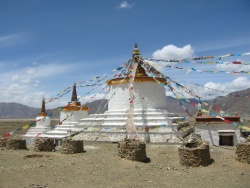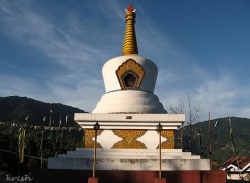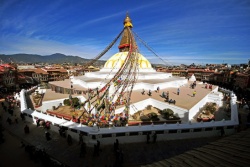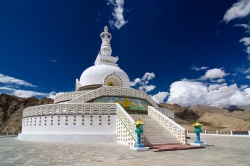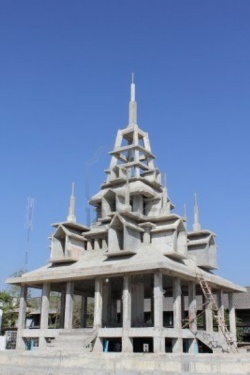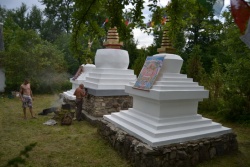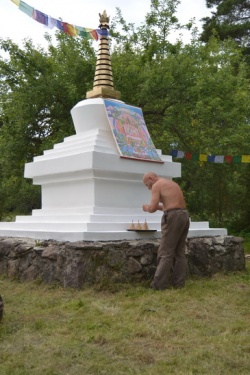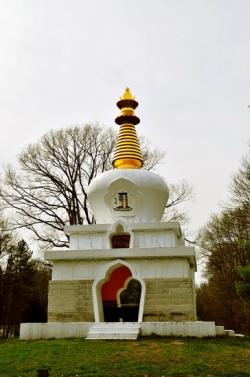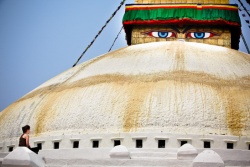Stupas: Incalculable Sources of Blessing
A teaching by Tulku Sang-ngag Rinpoche
Born in the Kham region of Tibet in 1952, Tulku Sang-ngag Rinpoche has studied with some of the greatest masters of our time, including H.H Dilgo Khyentse Rinpoche, H.H. Dudjom Rinpoche, & H.H. Chatral Rinpoche. During his 14 years of study with H.H. Khyentse Rinpoche, he studied all aspects of stupa creation and is now known as a preeminent master of the construction and consecration of stupas, which he has done around the world. Since his first visit to the U.S. in 1993, he has founded centers and encouraged the practice of the teachings in the U.S., Taiwan, and several other countries. Rinpoche has established the main seat of his North American activities in Arlee, Montana.
In 1993, he conferred the Padgyal Lingpa and Tsa Sum Lingpa transmissions at Chagdud Gonpa Rigdzin Ling in northern California. In the summer and fall of 1995, he returned to Rigdzin Ling at the request of H.E. Chagdud Rinpoche to guide the construction and consecration of eight stupas with Chagdud Gonpa T'hondup Ling's Lama Gyatso.
The following is taken from edited transcripts of a teaching by and an interview with Tulku Sang-gnag conducted at Rigdzin Ling in September 1995 and translated by Richard Barron. The eight stupas at Rigdzin Ling are the same as those referred to in this teaching. Their design and construction are based on the instructions of Shakyamuni Buddha contained in the "Two Stainless Cycles" discussed here by Tulku Sang-gnag.
In order to attain buddhahood so that all sentient beings, who have been our mothers, may attain buddhahood as well, it is necessary for us to gather the two accumulations of merit and pristine awareness and at the same time to purify ourselves of the twofold obscurations—those of the afflictive emotions and those of ignorance concerning the nature of reality. There are no means in the sutra or the tantra tradition to attain buddhahood without this twofold process. The Vajrayana offers very profound and unique means for doing so. It is geared toward people of the highest acumen, provides many skillful means that do not involve a great deal of hardship compared with other paths, and is extremely precise about the understanding of the nature of reality that comes about through such practice.
Any kind of physical effort associated with creating or honoring a representation of enlightened form, speech, or mind such as prostrations, circumambulations, or pilgrimage is a way of gathering the accumulations and purifying obscurations. Just as statues are representations of the enlightened form of Buddha and texts are representations of enlightened speech, stupas represent enlightened mind.
The Artistic Tradition of Buddhism
The artistic tradition of depicting the form of the Buddha Shakyamuni in a painting or as a statue began when the Buddha was in India and, in a sense, bore his seal of approval. It was he who initiated the tradition. A princess of Sri Lanka (called Singala in those days) once overheard a group of Indian merchants talking. One of them chanted what she thought was a popular song whose words really attracted her and captured her mind. She immediately approached the merchants and asked them about the source of the song. They told her, “Those words are the teaching of the Buddha.” Upon hearing this reply, the princess experienced an upwelling of faith in the Buddha, even though she had never met him.
She composed a letter to the Buddha, which she sent back with the merchants, requesting that some representation of him be sent to her as an object of her faith. In agreeing to her request, the Buddha commissioned an artist to paint his portrait. But so resplendent was the Buddha's form, radiating light and marked with the thirty-two major and eighty minor marks of physical perfection, that the artist couldn't reproduce it. So the Buddha emanated light from his body which created an image on the canvas. And it was this image that was sent, with his blessing, to the princess of Sri Lanka.
As she beheld this self-occurring miraculous portrait, the princess felt as though she has walked into the presence of the Buddha himself. Her afflictive emotions fell away and an unborn state of realization arose in her mind. She had the portrait put on display in the palace and summoned the entire population to view it. In its presence, many people experienced the kinds of realization that would normally require a great deal of spiritual practice. So sacred was the image that it produced some degree of liberation whether people saw it, heard of it, called it to mind, or touched it.
Following the Buddha's miraculous creation of his image on canvas, a great number of master artisans began to depict the Buddha's form in paintings, as statues, and so forth, many of which commemorated the deeds the Buddha performed in India. This artistic tradition continued after the Buddha's lifetime, throughout the history of Buddhism. Some of the greatest masters of the Indian Buddhist tradition, such as Nagarjuna, were famed for their artistic endeavors as well as their philosophy, writing and spiritual practice. They commissioned or actually created themselves large numbers of artworks depicting the Buddha. As well, political leaders and rulers were often instrumental in sponsoring the arts. Perhaps the most famous was King Ashoka, who filled with whole of South Asia with works of art commemorating the Buddha, his teachings, and his deeds. During his reign, Ashoka was responsible for erecting more than one million stupas. Three or four of these remain in Nepal today, as does a very large stupa in Varanasi.
Self-Arising Stupas
It's not as easy to pin down exactly when the first stupa was created. One reason for this is that the term “stupa” has a number of interpretations. In general, when we speak of a stupa, we are referring to a representation of enlightened mind, and so that the stupa does not have to have a physical shape or refer to a physical object. One of the verses attributed to the Buddha states, “Homage to stupas with form and without form, wherever these stupas may be in any direction or in any time.”
There are five main categories of stupa: self-arising, or spontaneous; unsurpassable, or superb; those created by the blessing of the Buddha; those that arise due to siddhi, or spiritual accomplishment; and those that represent the various yanas, or spiritual approaches, of the Buddhist teachings.
One meaning of “stupa” is that it is a self-arising spontaneously occurring phenomenon. In this sense, the configuration of the entire universe—conceived in traditional Buddhist cosmology as four continents surrounding Mount Meru as the central axis, crowned by the realm of the gods with the wish-fulfilling tree growing in it—can be understood as a gigantic stupa. On an inner level, the structure of the “vajra aggregates” of the subtle body, the way a person's mid-body aggregates and sense faculties—all the elements of the individual's experience of the world—fit together and interact, arises as a stupa as well and corresponds to the configuration of the universe as a macrocosm.
There is also a direct correspondence between the architectural features of a stupa and the way the universe is structured. The base and the steps of the stupa correspond to the six realms of beings in the desire realm. The middle, spherical section—the bumpa, or vase—corresponds to the seventeen levels of the form realm. The spire and the ornaments on top of the stupa correspond to the four stages of the formless realm. The srog shing, or central axis, the pole that runs through the center of the stupa, corresponds to dharmadhatu, the basic space of all phenomena.
The reference in the Buddha's teachings to qualities of mind foundational to the attainment of enlightenment—for example, the four immeasurable qualities of love, compassion, joy, and equanimity—are reflected in the design of four-sided stupas. The unsurpassable stupa has four sides in the four cardinal directions, which correspond to these four immeasurable attitudes and to four of the five Buddha families. The rituals associated with the preparation of such stupas clearly indicate that the eastern wall of the vajra family corresponds to the quality of love, and so forth, in the four directions. In the anuttara yoga teachings as well, the mandala is surrounded by what are called the charnel grounds as pure analogies of the eight aggregates or ordinary consciousness, each of which is described as containing a self-arising stupa.
It is said that at Bodh Gaya, where the Buddha attained enlightenment, there is a crystal stupa under the ground formed of a “vajra substance” from the bones of a rishi, or seer, whose meditative absorption was so powerful that it actually transformed his bones into a diamond-like substance that will not be destroyed even when the four elements are destroyed. This underground stupa, this spontaneously present representation of enlightened mind, adorned by the bodhi tree growing on the surface of the earth, provides a unique support for that site, such that all one thousand buddhas who will appear during this age will attain enlightenment at Bodh Gaya.
In some of the Vajrayana teachings, it is stated that a self-arising stupa exists in the sky above Bodh Gaya, although it is visible only to people with a high degree of realization. The Dzogchen teachings describe the “three sources”—three things that must be present in this world for the Dzogchen teachings to remain here. One of these is this self-formed stupa.
On the surface of the earth there are incredible stupas as well. Perhaps one of the most well known is the stupa of Awayambhu in the Kathmandu Valley, the very name of which means “self-arising.” It is said that there has been a stupa at that site since four buddhas prior to Shakyamuni. In the time of the first two buddhas the stupa was in the sky above the site, in the time of the last Buddha before Shakyamuni it was under the earth, and in the time of Shakyamuni it came to the surface of the earth. To this day, around the full moon in the sixth month of the lunar calendar, there is a remarkable apparition of the original stupa in the sky which countless numbers of people have seen—Buddhists and non-Buddhists alike. It is as though the stupa on the earth's surface levitates. This apparition is said to appear because there has always been a stupa at Swayambhu, in the sky, under the ground, or on the surface of the earth.
History of Buddhist Stupas
When the being who attained enlightenment as the Buddha Shakyamuni first entered the path and turned his mind away from samsara and toward liberation, he did so in the presence of a stupa. From the accounts of the Buddha's previous lives, and of the stupas at Bodh Gaya and Swayambhu, it is clear that the phenomenon of the stupa predates the Buddha. Since his lifetime, the stupas that have been built by Buddhists all over the world are representations of his form or memorials of his deeds and are constructed according to guidelines established in his teachings.
There are two basic approaches to the design of stupas: the Hinayana and Mahayana. The Tibetan tradition follows the teachings of the Indian master Nagarjuna, based in turn upon the Buddha's teachings, so it falls within the Mahayana tradition. In the Hinayana view, the shape of the stupa derives from the way the Buddha's personal belongings were heaped on a seat built by his students following his passing into parinirvana. Directly on top of the seat they piled his mat and robes, then his begging bowl, staff, and finally a little umbrella.
The Mahayana system of stupa design and construction was perhaps rarer in the Indian tradition than the Hinayana system was, but it was not absent. The way in which the Tibetans were taught to design and build stupas by the Indian masters who came to Tibet was based on the teachings of the Mahayana canon and, in the case of the Vajrayana forms of stupas, on explanations and instructions in the tantras. Perhaps the most well known designs of Tibetan stupas are a series of eight that are often built together. These are based on designs of stupas built by students of the Buddha in eight Indian holy places that were associated with various miraculous deeds he performed. For example, there is a design known as the “stupa of heaped lotuses” which is based on the accounts of the Buddha's birth in Lumbini Grove. When the Buddha was born miraculously from the left side of his mother's body rather than through the birth canal, he immediately stood upright and walked seven steps in each of the four cardinal directions. Wherever his feet touched the ground, lotuses bloomed, forming heaps of blossoms. And so the design of this stupa suggests a heap of lotus blossoms. Similarly, a stupa with a design known as the trashigomang—meaning the “many doorways of auspiciousness,” referring to the Buddha's many avenues of teaching—was erected as a memorial to the Buddha's first turning of the wheel of the dharma in Varanasi, when he taught the four noble truths and the twelve links of interdependence, the beginning of the process that led to the 84,000 collections of his teachings. Of the other six stupa designs, the enlightenment stupa commemorates the Buddha's enlightenment, the stupa of descent from the god realm commemorates his descent at Sankhya from the Tushita Heaven after teaching his mother, the stupa of miracles commemorates the miracles he performed at Shravasti, the stupa of reconciliation commemorates his reconciling the quarreling factions of the sangha at the Bamboo Grove, the stupa of nirvana commemorates his death and passing beyond sorrow at Kusinagara, and the stupa of complete victory commemorates his voluntary prolongation of his life span at Vaisali. Each of these has a specific form. For example, the reconciliation stupa is spherical, representing the idea of wholeness, of bringing everything back into a single group.
When the Buddha passed into parinirvana, his relics were gathered, divided into eight equal portions, and given to eight different groups of individuals, who took them back to their home countries and built stupas to enshrine them. These stupas were not so different in shape, but were simply built in eight different locations.
The Buddha's Instructions for Stupa Construction
In terms of the practical means by which a stupa is designed and constructed, the rituals are performed, and the substances are prepared, the majority of accomplished Tibetan masters have relied on the teachings the Buddha Shakyamuni gave in the human realm and the god realm. These instructions are contained in the Drimed Namnyiy, the “Two Stainless Cycles.” Regardless of the outer form of a stupa, the inner consecration is identical in every case and is based on these two cycles.
One of them, the Odzer Drimed or “Stainless Light Rays” cycle, was conferred by the Buddha when approached by a Brahmin named Sergyi Dawa. This Brahmin, far from being a Buddhist, was a learned teacher of an extreme philosophical view that was at a real variance with the Buddha's teachings, and he had thousands of students. Due to insight gained through meditation, he had a premonition that he would die within seven days, which frightened him very much. He wanted to save himself, but was powerless to do so. He had heard a great deal about the compassion and wisdom of the Buddha, and so he went to him for help. The Buddha's first response was, “You have every right to be concerned. You're facing not only an untimely death, but such a store of negative karma that your mindstream will be reborn again and again in lower and lower realms of existence until you are finally born in a hell realm.” The Brahmin replied, “You are omniscient; please give me the means to offset this obstacle.” The Buddha answered, “Under normal circumstances, you would experience this suffering, but there is no need for you to do so. There is a stupa in a certain location. All you have to do is repair, refurbish, and reconsecrate it and you will gain enough merit to offset your negative karma.” So out of his compassion the Buddha transmitted teachings, mantras, dharani mantras, and the means of constructing and consecrating a stupa. Then he said, “Your life at present is similar to a lamp running out of oil. This will be like pouring oil into the lamp and sustaining your life force. It will also exhaust the negative karma that would have led to rebirth in lower states. When you finally pass from this life, like a snake shedding its skin you will leave the world behind and attain rebirth in a pure realm, a realm of bliss.” So overjoyed was the Brahmin that he took what the Buddha said to heart. He used all of the means that had been placed at his disposal to restore and reconsecrate the stupa.
Through the power of the Buddha's words, the power of the mantras and the dharani mantras that the Buddha transmitted, and through his own efforts, the Brahmin experienced a miraculous transformation. His sick and dying body became a strong, majestic presence and he lived for a long time. The effects of this astonished Buddhists and non-Buddhists alike. The bodhisattvas who were students of the Buddha were amazed that he had bestowed such powerful kriya tantra teachings. Recognizing their very special nature as a means of purification and spiritual development, the bodhisattvas codified them, thus providing the scriptural sources for this unbroken lineage of practical methods for building and consecrating stupas.
When the Buddha presented these teachings to Sergyi Dawa, there was a bodhisattva in the audience whose name was Dribpa Namsel, which means the “complete dispelling of all obscurations.” At one point this bodhisattva arose and addressed the Buddha, requesting that he further elaborate the means by which stupas could be designed, erected, and consecrated for the benefit of sentient beings. Delighted by this request, the Buddha proceeded to explain in great detail how a stupa could be constructed using earth, rock, wood, and so forth. He said that whether the stupa was as large as Mount Meru or as small as a fingernail, what was important for rendering it a sacred representation of enlightened mind was the proportions. He described the way the mandalas were constructed, the way the dharani mantras were prepared, the way the tsa tsas, or clay images, were formed and consecrated. He emphasized the need for ritual purity, the strictures incumbent on people who prepared the tsa tsas, dharani mantras, and other offerings—the taking of ordination, a vegetarian diet, and so forth. He also explained how the formal consecrations were to be performed, as well as the benefits of building a stupa.
The Blessings of Stupas
The benefits of involvement in the creation of stupas and tsa tsas are truly incalculable. When the Buddha gave these teachings, not only the human beings but also the gods, spirits, and other nonhumans present recognized their value and promised to honor, respect, and preserve them. Throughout the history of Buddhism careful attention has been paid to maintaining this tradition of stupa construction.
Participating in or sponsoring the creation of tsa tsas or stupas, as well as honoring them after they are built through prostrations, circumambulations, and offerings, provides a means for averting all that is inauspicious or counterproductive and of assuring all that is auspicious and supportive of spiritual development. Whatever the short-term goal—whether is be longevity, wealth and prosperity, the accomplishment of an undertaking, the alleviation of illness for oneself or others, the purification of even the most heinous act, the pacification of obstacles—this activity is a very powerful means for realizing that goal. As well, it plants the seeds of liberation in one's mindstream, so that one gains higher states of rebirth and ultimately is brought to enlightenment. This is particularly dependent upon one's bodhicitta. If one participates in a stupa's construction and ritual activities, or honors the completed stupa with an altruistic resolve to benefit all beings, then the blessings are such that the Buddha himself could not describe them.
We should never underestimate the power of our aspirations. That power can be negative as well as positive. The Legend of the Great Stupa tells of the three brothers who constructed the stupa at the request of their aging mother, and took a vow to be reborn together under circumstances where they would benefit beings. They were reborn as the scholar and abbot Shantirakshita, the great master Padmasambhava, and the king T'hrisrong Detzan. It was during the time of these three figures in Tibetan history that the Buddhist tradition flourished in the Land of Snows. When they took their vow as the three brothers, another individual who was jealous of them formulated a very negative prayer: “May I be reborn in circumstances where I can destroy everything they build.” Because it was formulated during the construction of the stupa, the force of this aspiration led to the person's rebirth as the very powerful King Langdarma. But due to the negativity of the aspiration, as the king he committed a great deal of evil, virtually eradicating Buddhism in Central Tibet at one point.
The blessings of stupas are such that they benefit all beings, regardless of their connection or motivation. The fact that there are stupas and other sacred embodiments of enlightened body, speech, and mind at Rigdzin Ling may be something that people who live just a few miles down the road have no idea about. This doesn't mean that they won't benefit in some way. The world benefits from the fact that Rigdzin Ling is here. The state benefits. The local area benefits. There is benefit on all levels. But that benefit is increased by one's participation and one's bodhicitta. A stupa is especially beneficial to those who sponsor or build it, see it or hear the wind that blows by it, touch or remember it, but that does not mean that it is not beneficial to other beings. It is really more a question of the degree of benefit.
There is an account in the Jataka Tales of seven insects living on a leaf of a tree next to a lake at the bottom of which was a stupa. When winter came the tree shed its leaves. The wind carried the bugs' leaf seven times around the lake, and then it fell in the water and the bugs drowned. Following the Buddha Shakyamuni there were seven generations, known as the first seven generations of buddhas, who were incarnations of these seven insects. Now that's benefit! The bugs had no idea the stupa was there. They didn't know what was going on. They were just carried by the wind.
In Tibetan Buddhism, the making of tsa tsas is an extremely powerful means of developing one's merit in preparation for any major undertaking. Retreat manuals often say that before a long retreat you should gather merit by activities such as making tsa tsas. It is also a powerful means of purifying the effects of harmful actions, obscurations, and broken vows or commitments.
There is an interesting story in this regard about Atisha, the great Indian Buddhist master who was the disciplinarian at Nalanda University, and Naropa, a fully ordained monk at Nalanda. At a certain point in his Vajrayana practice it became appropriate for Naropa to take a consort. It was brought to the disciplinarian's attention that Naropa was consorting with a woman. So Atisha felt bound to expel him from the university. He went to Naropa's chambers and explained the situation. Naropa replied, “Well, if that's how you feel, fine.” He took his robes off, put them down, walked through the wall, and left the university—at which point Atisha realized he had made a mistake! The residents of the monastic university were upset with him for having failed to recognize a great siddha living among them. Atisha was so distraught that he decided he had to leave too.
Now Atisha was a great practitioner of Tara, and his relationship with his chosen deity was such that he had visions of Tara constantly and he could speak to her whenever he wished. But for seven days after this incident, she was nowhere to be found. Finally one morning at dawn she appeared to Atisha and said, “You have committed a very great fault. If you do not confess and purify your actions toward this great yogi, your mindstream will be reborn in hell.” And then she vanished.
And so Atisha set off to find Naropa. He finally came upon him walking across the Ganges River. Since Atisha was not quite up to that, he wasn't able to offer Naropa his personal apology. But Tara again appeared to him and said, “One of the ways in which you can offset this negative karma is to make five tsa tsas every day for the rest of your life.” So this became a part of Atisha's practice. When he came to Tibet, his students were astonished to see this great master from India sitting on the floor every day with his clay and mold making tsa tsas. It embarrassed them and so they said, “A great lama such as you shouldn't have to do this kind of menial work. We will do it for you.” But Atisha simply replied, “Are you going to eat my food for me too?”
When we were creating the stupa in Bhutan commemorating H.H. Khyentse Rinpoche, there was never any need to exhort people to work. Not only were the great lamas there day and night making tsa tsas, rolling mantras, and so forth, but people were flocking to help. They understood the value of what was going on and wanted to be a part of it. There was no need to encourage people. If anything, it would have been necessary to turn people away because there were just too many. Because it was wintertime and really cold, building the sides of the stupa was extremely hard work. Yet lamas and tulkus were practically racing each other for the honor of being able to get up the scaffolding and start plastering.
The oldest of His Holiness' students were getting on in years and had arthritis in their fingers. Yet they couldn't wait to get to the work site. They'd run out there and help in any way they could, scooping up concrete with their bare hands and plastering it on because they were so happy to take part in the work. One of the interesting features of stupas is that it's hard to feel possessive of them. They don't exist for any other reason except to benefit. With other projects, there may be some vested interest. But a stupa is just a stupa. It's not something you can personally profit by. It's a representation of enlightened mind, sitting there, waiting for beings to see, touch, or remember it. In Tibet a lot of the stupas were built at crossroads on high mountain passes, places where nobody would ever go except on their way to somewhere else. Tibetans knew that no matter what stupas looked like on the outside, they contained incredible blessings. Just to see them was a blessing. To touch them was a blessing. To hear the sound of the wind blowing around them was a blessing. And that was why they built them—for the blessings, just the blessings.
